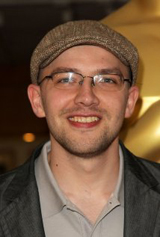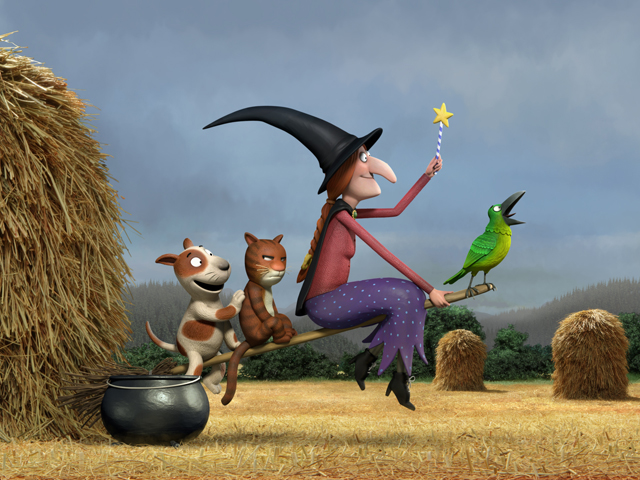One of the 10 animated shorts that have advanced for voting for this year’s 86thAcademy Awards, Room on the Broom, by Max Lang (Director of Oscar Nominated ‘The Gruffalo’) and Jan Lachauer was first premiered in 2012 on the occasion of Christmas and also had a cinema release in France.
Recognized by many coveted awards throughout the last year including the Cristal for the best television production at Annecy and most recently a BAFTA for best children’s animation, the short has also been nominated for Annie and International Emmy.
While we wait to see if ‘Room on The Broom’ makes it to the final 86th Academy Awards nominations that will be announced live on Thursday, January 16, 2014, at5:30 a.m. in the Academy’s Samuel Goldwyn Theater,
nominations that will be announced live on Thursday, January 16, 2014, at5:30 a.m. in the Academy’s Samuel Goldwyn Theater,
 nominations that will be announced live on Thursday, January 16, 2014, at5:30 a.m. in the Academy’s Samuel Goldwyn Theater,
nominations that will be announced live on Thursday, January 16, 2014, at5:30 a.m. in the Academy’s Samuel Goldwyn Theater,
AnimationXpress.com, brings you exclusive chat with Max Lang to know more about the Making of ‘Room on The Broom’ and he starts off the conversation with us by saying, “While the plot itself is quite simple, it becomes much more complex once you start thinking about it from the characters’ point of view.”
Hi Max, it is pleasure to have a conversation with you, before moving onto your short films, can you share a little about yourself?
I studied animation at the ‘animation school hamburg’ and the ‘Filmakademie Baden-Wuerttemberg’. One of my teachers at the Filmakademie was Jakob Schuh, who’s also one of the founders of nearby studio soi. Jakob and I became friends and started working together. ‘The Gruffalo’ was my first job as a storyboard artist, and when Jakob was looking for a co-director, everything fell into place naturally. After the Gruffalo I moved to England to work as Assistant Director on the Cartoon Network series ‘The Amazing World of Gumball’. I’ve since become a dad, got married and decided to stay in England. Since my daughter was still a baby when we started ‘Room on the Broom’, I did most of the work from home, while Jan Lachauer, a long time friend of mine, co directed the film in Ludwigsburg.
What are you currently working on?
At present, my wife and I are working on our first picture book for Random House. It’s all very new and exciting. The process is very different from animation, even though it’s both visual storytelling.
How did Room on the Broom happen and what is this short all about?
How did Room on the Broom happen and what is this short all about?
Room on the Broom is based on a famous picture book by Julia Donaldson and Axel Scheffler. It’s a very sweet and simple story in rhyming couplets about a witch and cat that take on more and more passengers on their flying broomstick. When Magic Light Pictures approached me with the book, I fell in love with the story and its characters immediately and saw a lot of potential for the film.

Define the characters and setting that one will see in Room on the Broom?
Here’s a brief summary of the film that I wrote early on that was used to give artists a quick introduction to the film we wanted to make with them: ROTB is a story of change and company. More and more characters join the well-balanced team of Witch and Cat on their magic broom. With each new member, their journey gets harder and harder until the broom breaks. But in the end it turns out that even if it‘s much harder to travel together, there are some obstacles that you don‘t want to face alone.
That even if you are much faster on your own, you get much further as a group.
And that it‘s not the size of the broom that should define a group, but the size of the group that should define a broom.
And that it‘s not the size of the broom that should define a group, but the size of the group that should define a broom.
Color Keys
So Max, when it comes to translating a picture book into an animated short, how much liberty did you get for adding your own characters?
We tried to stay as true to the book as possible. Even most of the side characters appear in Axel Scheffler’s illustrations. Sometimes we included some characters from ‘The Gruffalo’ as a little homage but only if it made sense for the story. Plotwise we hardly changed anything and instead extended the story by exploring the characters, focusing on their different personalities and relationships with each other.
How was the work divided between Magic Light Pictures and Studio soi?
Magic Light Pictures is the production company behind the Gruffalo films and Room on the Broom. They hold the rights, put together the finance, develop the project with the directors, and oversee the production of the film until the very end. Studio soi helped to develop the film, created the sets, animation and final images.
Shoot
What was your focus while carrying out the pre production?

We spent a lot of time storyboarding. Most of the film is told visually, so this is the only way to really find out if an idea is working or not. On the visual side we focused on adapting Scheffler’s graphic illustrations into a 3-dimensional world. Jan and I mostly worked on the characters. The world itself was created with the help of Manu Arenas, a very talented concept artist, Aurelian Predal, who did the colour script, and the fantastic set-builders Klaus Morschheuser and Katja Moll.
Please shed more light on the look and feel?
The look is very much based on The Gruffalo, but the sets were built on a much smaller scale. This resulted in greater detail but also in a very shallow depth of field. We sometimes had to take more than 10 pictures and combine them into one clear image. Generally I like it a lot when the surface of 3 dimensional characters is treated more abstract and artistically, like it was actually built. It just looks bizarre to me when cartoon characters have a photo real skin, especially when the characters’ proportions and shapes are less realistic.
Can we know more about the research and references that you went through while creating the short?
Next to the actual Illustrations; we took a lot of inspiration from British nature and countryside. We wanted to open the illustrations and extend them into vast and epic landscapes, to transport the feeling of flying and travelling.
Are the dialogues different from the comic book?
I don’t think we changed any of the actual lines of the book. We sometimes repeated a word or a phrase for dramatic purposes but that’s about it. We made this choice because the rhymes of the book are memorized and loved by so many children and parents throughout the world.
Could you inform us about the animation mediums used?
Next to the actual Illustrations; we took a lot of inspiration from British nature and countryside. We wanted to open the illustrations and extend them into vast and epic landscapes, to transport the feeling of flying and travelling.
Are the dialogues different from the comic book?
I don’t think we changed any of the actual lines of the book. We sometimes repeated a word or a phrase for dramatic purposes but that’s about it. We made this choice because the rhymes of the book are memorized and loved by so many children and parents throughout the world.
Could you inform us about the animation mediums used?
The film is a combination of different mediums. The characters are CG because we wanted the freedom and subtleties in the performances that you only get from this technique. Most of the sets were actually built and shot in a workshop, but some BG’s are also painted or CG. Some of the FX are hand drawn, some are simulated, some are animated frame by frame. We looked at each shot and tried to find the best combination of techniques to tell the story. It’s a bit of a patchwork.
Why not completely CG?
A lot of charm and style in any artistic medium comes from imperfections. Little touches that you get from hand crafted work, where you can feel the artists’ presence. Of course you can add those things in CG as well to stay more flexible, but sometimes it’s also good to limit yourself and find creative solutions instead.
A lot of charm and style in any artistic medium comes from imperfections. Little touches that you get from hand crafted work, where you can feel the artists’ presence. Of course you can add those things in CG as well to stay more flexible, but sometimes it’s also good to limit yourself and find creative solutions instead.
ManuArenas_ConceptDesign
Max, you must have carried out a lot of acting for Animation too?
I mostly draw. Sometimes we act out scenes for each other when it’s the right situation, but personally I prefer to draw little sketches or storyboards. This also gives the animators the freedom to create their own performances in bringing these sketches to life. I don’t want them to copy me but add their own take to the film.
How much time did the overall production take and what were the software used?
The production of the film took about 18 months, including 6 months of pre-production.The film was animated in Maya, rendered in Soft Image and composited in Nuke, and of course we used a lot of Photoshop throughout the production.
The most challenging part was?
The most challenging part was?
I think one of the big challenges was to combine all these different techniques into one film. This was done by studio soi’s very experienced composting department and took a long time to complete.
Did any last minute changes happen or did any aspect need a lot of re working?
Did any last minute changes happen or did any aspect need a lot of re working?
We try to do most of our planning and reworking during pre-production with storyboards and animatic. Still, we cut several shots in the editing room close to the end. Those scenes seemed necessary during the boarding but felt labored once the animators had added their performances.
No comments:
Post a Comment